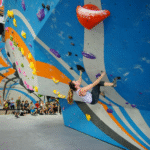Granada Hills, tucked into the northern stretch of the San Fernando Valley in Los Angeles, doesn’t shout for attention. It doesn’t clamor with flashy billboards or draw in tourists with over-the-top attractions. Instead, it hums with a quiet charm, the kind that reveals itself slowly to those willing to look just beneath the surface. To the outsider, it may appear as another patch of suburban Southern California—modest homes, tree-lined streets, corner strip malls—but to those who live here, it’s a pocket of comfort, character, and memories.
The first thing you notice in Granada Hills isn’t what’s visible—it’s what you feel. The pace of life here moves just a touch slower. Neighbors wave when they drive past. Dogs are walked by the same retirees who’ve lived in the neighborhood for decades. Kids still play outside until sunset, their laughter cutting through the rustling of palm fronds. It’s a place where roots grow deep—not just the trees, but the people too.
One of the most defining features of Granada Hills is its sunsets. There’s a kind of magic when the day winds down and the sky starts to blush with color. The hills to the north catch the fading light, and the streets take on a golden hue. Locals know the best place to watch it isn’t from a rooftop bar or the top of a skyscraper, but from somewhere quieter—perhaps the top of Rinaldi Street, overlooking the valley, or a simple bench in O’Melveny Park. Here, the sunset isn’t a show; it’s a ritual. Families linger outside longer. Couples pause mid-walk. The birds start to quiet, and even the air seems to shift. In those moments, it feels like time bows down to stillness.
Then there’s the citrus—less glamorous than a skyline, but just as telling of a place’s soul. Granada Hills was once home to sprawling orange and lemon groves. While development has replaced most of that, hints remain. Some homes still have backyard orange trees bearing fat, fragrant fruit. In spring, the scent of citrus blossoms drifts into open windows, mingling with cut grass and the occasional whiff of barbecue. It’s a scent that triggers memories childhood lemonade stands, bags of backyard oranges left on neighbors’ porches, the sticky sweetness of juice running down your chin under the summer sun. These trees are more than flora—they are anchors to the neighborhood’s agricultural past, quietly resisting the full sweep of urban sprawl.
Granada Hills is also a place of stories—hundreds, maybe thousands, woven into the quiet rhythm of daily life. There’s the story of Balboa Boulevard, once a dirt path through ranch lands, now a central artery lined with schools, churches, and taquerias. There’s the story of the old drive-in theater that once stood off Devonshire, now a fading memory for those who parked there in the 60s and 70s on Friday nights, sipping sodas and kissing behind fogged-up windshields. And then there’s the story of the Granada Hills Street Fair, a beloved annual event where local businesses, families, and community groups turn the street into a celebration. It’s a day of music, face painting, food trucks, and handmade crafts. You’ll see high school students performing onstage, old-timers talking about “how it used to be,” and newcomers marveling that such a community could still exist in a city as sprawling as Los Angeles.
Locals often speak fondly of the food. It’s not haute cuisine, but it’s satisfying, personal. There’s the Thai restaurant that’s been family-run for 20 years and knows your order before you sit down. The Italian deli on Chatsworth where you can still get a sandwich bigger than your face and the owner greets you like family. The small Korean barbecue spot hidden in an unassuming strip mall that has the best banchan in the Valley. Granada Hills has quietly become a patchwork of cultures, with each cuisine adding flavor to the landscape—Salvadoran pupusas, Armenian kebabs, Persian stews, Vietnamese pho. The real joy comes from finding your own favorites, the tucked-away gems known only to locals and passed along through whispers rather than online reviews.
Perhaps the most emblematic place in Granada Hills is O’Melveny Park. At over 600 acres, it’s the second-largest park in Los Angeles, and yet it rarely feels crowded. It’s where locals go to breathe, hike, picnic, or just watch the seasons shift in the chaparral-covered hills. Spring brings wildflowers, summer bakes the trails golden, fall turns the trees rust-colored, and winter brings mist that hugs the ground in the early morning hours. The park is also a place of memory. You’ll see grandparents with binoculars watching birds, teenagers posing for prom pictures beneath the trees, and toddlers discovering what dirt feels like between their fingers. It’s a place that offers space—not just physical, but emotional. Space to reflect, to walk slowly, to escape the pulse of the city even while still within it.
The people of board and care Granada hills carry their own quiet pride. They don’t boast, but they notice. They notice when someone plants a new tree in their front yard. They notice when a child rides a bike without training wheels for the first time. They notice when a neighbor’s house gets repainted, or when the new family down the street moves in and needs a welcome. It’s the kind of place where community still means something, not in a performative sense, but in the daily acts of small kindness that accumulate over time. The borrowed sugar. The shared driveway snow shovel in rare rainy winters. The knowing nods at the post office or the supermarket line.
There are, of course, modern pressures. Rising home prices. Traffic on the 405. The creeping spread of chain stores that threaten to blur the area’s distinctiveness. But somehow Granada Hills holds on. Perhaps it’s the strong neighborhood councils or the passion of local historians who keep the stories alive. Maybe it’s the schools that consistently rank among the best in the Valley or the PTA parents who still organize fundraisers with bake sales and raffle tickets. Or maybe it’s just inertia—when a place has been loved for so long, it tends to keep being loved.
Even the street names in Granada Hills tell tales. Zelzah, Haskell, San Jose—each one echoes the layered history of this place. Some are relics of Spanish land grants, others nods to the area’s agricultural roots. You drive down streets lined with jacarandas in spring, the purple blossoms falling like confetti onto sidewalks and windshields. In December, a few neighborhoods still go all out with Christmas lights—elaborate, coordinated displays that draw cars full of families slowly cruising past, pointing out their favorites.
It’s not unusual for generations of the same family to live within a few blocks of each other. A grandmother on Rinaldi, her children on Encino Avenue, and grandchildren attending the same elementary school she once walked past as a child. It’s in these layered generations that Granada Hills finds its continuity. Time changes the paint on the walls, the logos on the signs, the models of the cars in the driveways—but the essence remains. That essence is one of stability and subtlety, the unspoken agreement among residents to preserve what makes the neighborhood special.
Every local has their favorite spot. Maybe it’s the quiet stretch of Zelzah Park, where early morning dog walkers share coffee and conversation. Or the used bookstore off Chatsworth where the owner has read everything twice and can recommend a novel based on your mood. Or the Friday night car meet-ups in parking lots, where classic muscle cars and custom imports sit side by side, admired by teens and retirees alike. These little places matter. They form the constellation of memory and meaning that defines what home feels like.
Sometimes the joy of Granada Hills is in its ordinariness. The routines that aren’t dull but grounding. Morning walks to the corner coffee shop. Kids’ soccer games at Petit Park. A random Tuesday afternoon when you realize the jacarandas are starting to bloom again. The small talk at the dry cleaner, the comfort of a familiar face at the pharmacy, the sound of leaf blowers and sprinklers at 8 a.m. on a Saturday. These are the rhythms of real life, not curated or filtered, but lived.
Visitors may ask, “What is there to do in Granada Hills?” Locals might chuckle and respond, “Not much. But that’s the point.” It’s not a place designed for spectacles or headlines. It’s a place built for living well. For raising children. For knowing your neighbors. For staying put. For seeing the same hills at sunrise and sunset for decades and never tiring of the view.
As the sun dips behind the western horizon and the sky glows orange and pink, you’ll hear the faint sound of sprinklers ticking on, the chatter of families settling in for dinner, the wind shaking leaves on the old citrus trees. Stories settle into the streets like dust. The kind of stories you don’t need to write down because everyone already knows them. And for those new to Granada Hills, the invitation is quiet but sincere take your time. The beauty isn’t in what hits you at first glance. It’s in what lingers after. It’s in the way you’ll remember the smell of orange blossoms long after you’ve left. It’s in the way the sky looked that one night when everything else was still. It’s in the people who smiled and waved even when they didn’t know your name yet.















